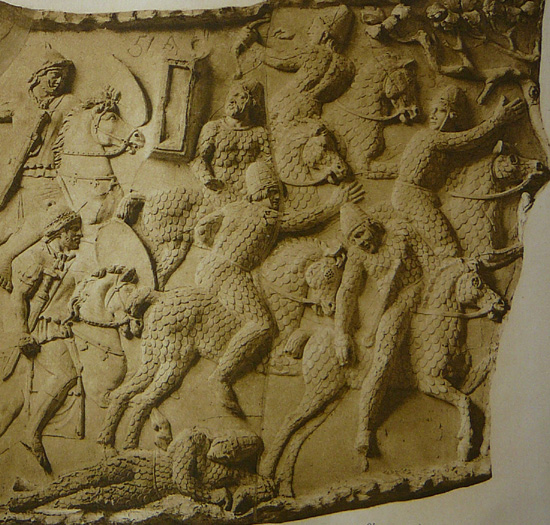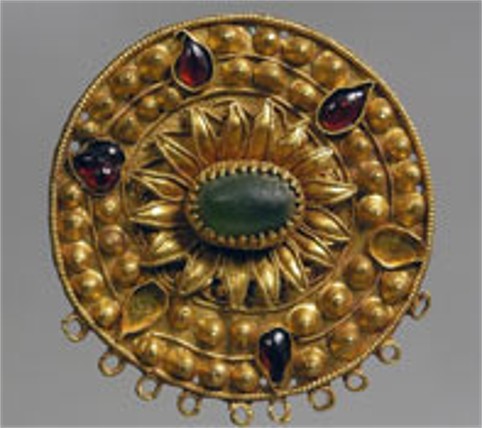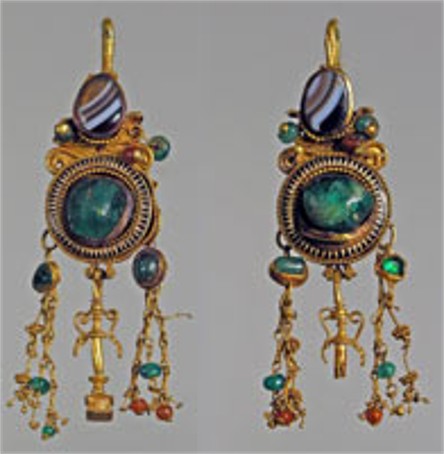Sarmatians
Sarmatians (Ukrainian: сармати; sarmaty; Greek: Σαρμάται; Sarmatai; Latin: Sarmatae). A confederation of nomadic Iranian tribes (Aorsians, Alans, Roxolani, Siraces, and Iazyges; see Iranian peoples) related culturally to the Scythians. Originally, in the 7th to 4th centuries BC, they were known as Sauromatians. In the 3rd century BC the Sarmatians conquered the Scythians in the Crimea and thenceforth dominated the steppe between the Tobol River in Siberia and the Danube River. Most ancient and modern scholars (eg, Polybius, Pliny the Elder, Max Vasmer, L. Zgusta) have considered the Sauromatians and the Sarmatians to be the same people, but some (eg, Strabo, Mikhail Rostovtsev) have viewed them as distinct. Contemporary scholars (eg, K. Smirnov, T. Sulimirski) tend to view the Sauromatians as the older ethnic substratum and culture of the Sarmatians.
Having consolidated their power in Subcaucasia and the northern Black Sea steppe in the 4th to 2nd centuries BC, the Sarmatians began allying themselves with the Pontic states and helped the Scythians fight the Pontic general Diophantes. In the 1st century BC they were allies of the Pontic king Mithradates VI during his war with Rome. Thereafter the northern Pontic littoral was called Sarmatia, and it was so designated on M.V. Agrippa's map. Some Sarmatian tribes, notably the Roxolani and Iazyges, colonized what is today southern Bulgaria and Romania and had frequent conflicts with the Romans there.
The Sarmatians gradually became sedentary after penetrating the Hellenic colonies on the Pontic littoral (see Ancient states on the northern Black Sea coast) and settling in the Bosporan Kingdom. They took up agriculture and assimilated into local cultures there and in the forest-steppe region of Right-Bank Ukraine. Their political might was broken by the Ostrogoths in the 3rd century and the Huns in the 4th century. Some of the Sarmatians migrated west with the Huns and even reached as far as Spain and northern Africa. Those who remained behind intermingled with the indigenous Slavs and other peoples. The language of the Ossetians (Ossetes) in Subcaucasia has preserved certain Sarmatian elements.
The initially matriarchal character of the Sarmatian culture (eg, women warriors before marriage) gradually disappeared as the tribes became more organized, the political power of the generals grew, and new military tactics, armor, weapons, and riding equipment (metal stirrups) were introduced. The Sarmatians' cult of the sword and fire was reflected in their art, jewelry, and metal ornamentation of armor and weapons. Sarmatian archeological sites in Ukraine include the Sokolova Mohyla, Nohaichynskyi kurhan, and other kurhans.
BIBLIOGRAPHY
Rostovtsev, M. Iranians and Greeks in South Russia (Oxford 1922; repr, New York 1969)
Harmatta, J. Studies on the History of the Sarmatians (Budapest 1950)
Shelov, D. (ed). Voprosy skifo-sarmatskoi arkheologii (Moscow 1954)
Pasternak, Ia. Arkheolohiia Ukraïny (Toronto 1961)
Smirnov, K. Savromaty: Rannaia istoriia i kul'tura sarmatov (Moscow 1964)
Sulimirski, T. The Sarmatians (London 1970)
Khazanov, A. Ocherki voennogo dela sarmatov (Moscow 1971)
Terenozhkin, A.; et al (eds). Skify i sarmaty (Kyiv 1977)
Smirnov, K. Sarmaty i utverzhdenie ikh politicheskogo gospodstva v Skifii (Moscow 1984)
Bogucka, M. The Lost World of the Sarmatians: Custom as the Regulator of Polish Social Life in Early Modern Times (Warsaw 1996)
Bohdan Kravtsiv, Arkadii Zhukovsky
[This article originally appeared in the Encyclopedia of Ukraine, vol. 4 (1993).]

.jpg)
.jpg)



.jpg)